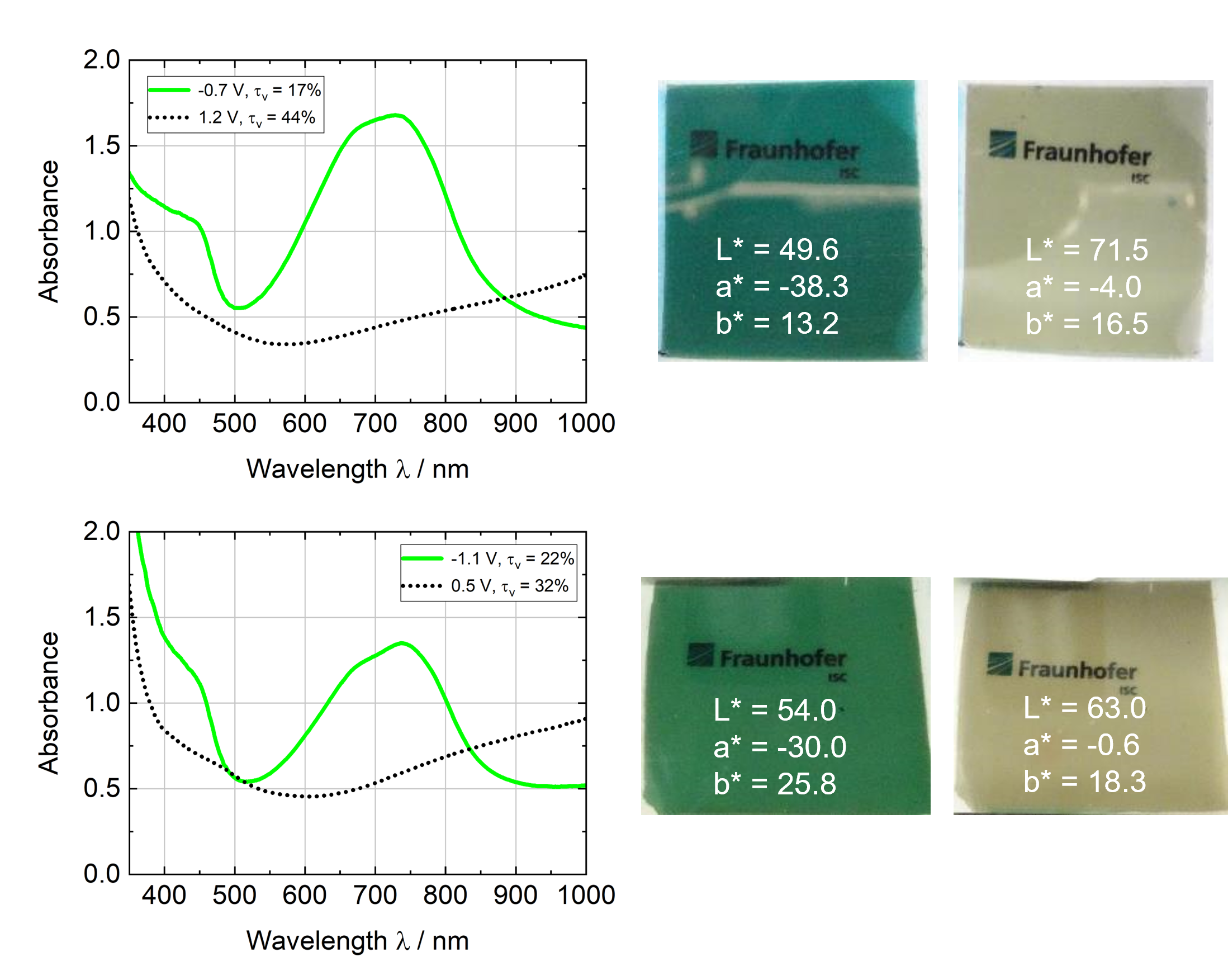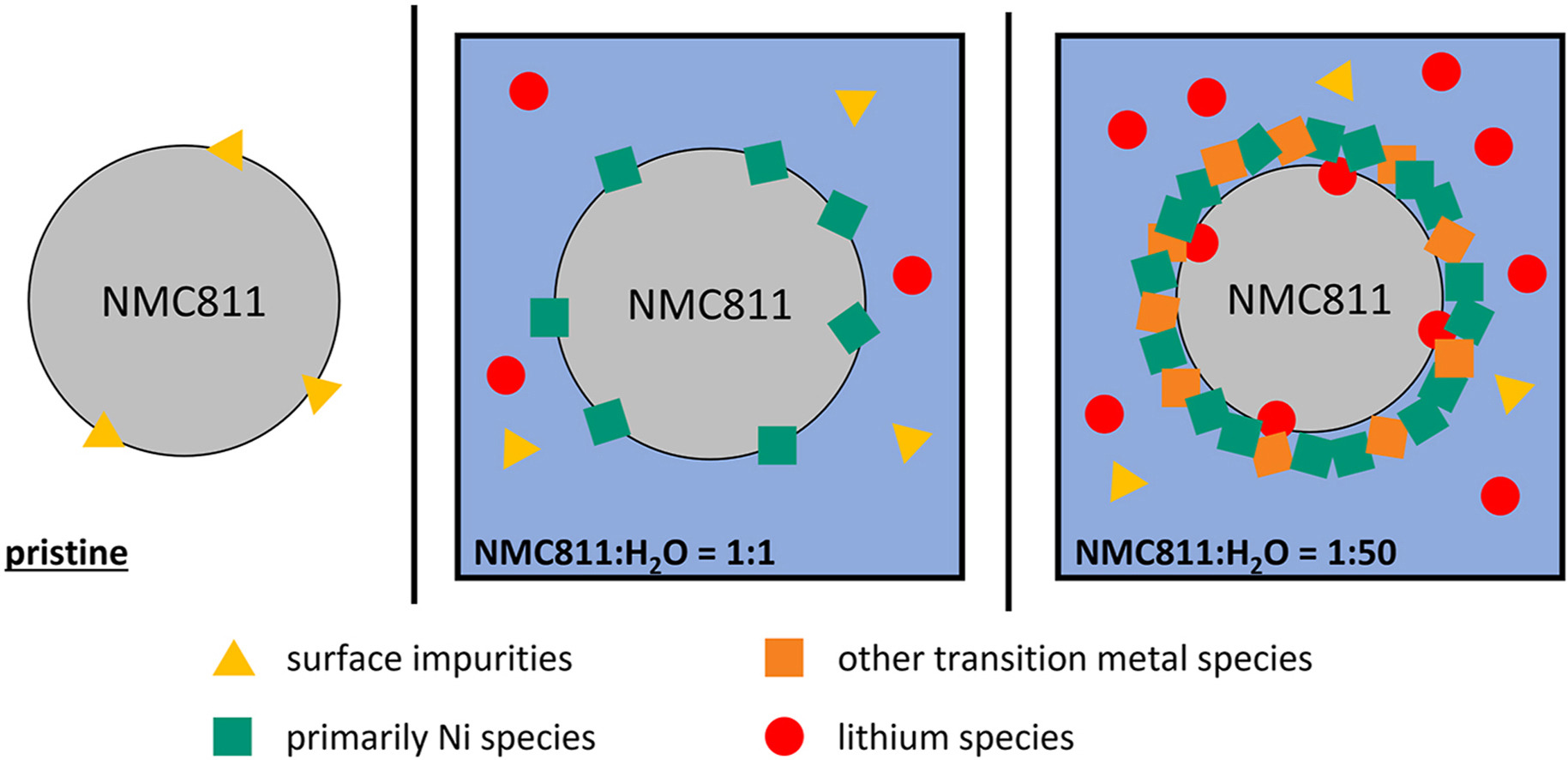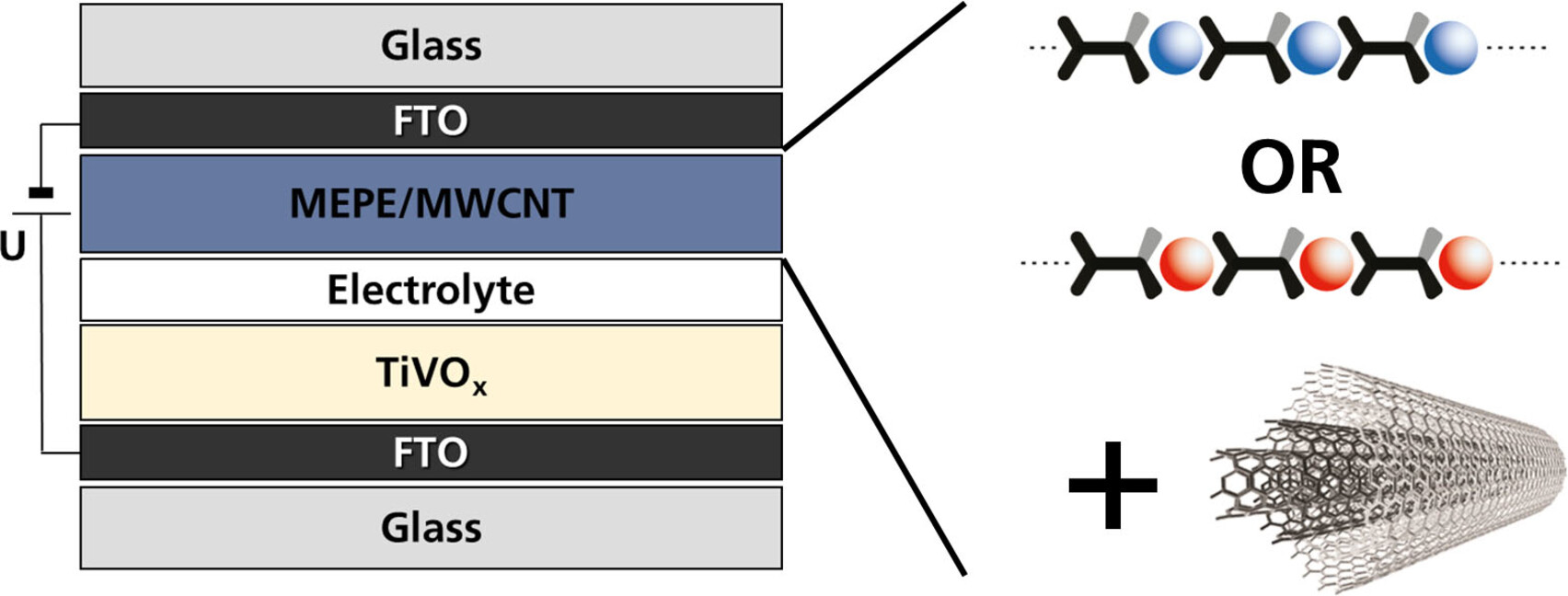Publications Fraunhofer R&D Center for Electromobility Bavaria
Recent Scientific Publications
Electrochemical Devices | Electrochromic Windows
Encyclopedia of Electrochemical Power Sources (Second Edition) / 2024
This chapter provides an overview of electrochromic (EC) glazing technologies available on the market or under development. EC systems for smart windows that are switchable between a colored and a colorless state or between different colored states by applying a low voltage or current can improve energy efficiency and comfort in buildings. Dynamic modulation in the visible (Vis) and near-infrared (NIR) regions of the electromagnetic spectrum enables an adaption of the thermal and optical behavior of a glazing system to ambient conditions. While the energy consumption for air conditioning and artificial lighting is significantly reduced, smart windows can continuously make optimal use of daylight and be tailored to personal needs using appropriate control algorithms.
Investigation of Acoustic Attenuation and Resonances in Lithium-Ion Batteries using Ultrasound Spectroscopy
Batteries & Supercaps / 2024
Ultrasound spectroscopy (up to 6 MHz) on a 12 Ah Lithium-ion cell reveals absorption and resonance components of attenuation. Two resonances are identified. The attenuation of the first resonance linearly decreases with state of charge. Matching interrogation frequency to this resonance yields a 5x signal amplitude increase across 0-100 % charge, potentially enabling robust state of charge determination.
Factors Impacting the Photostability of a Roll-to-Roll Processed PEDOT Derivative for Flexible Electrochromic Devices
Advanced Materials Technologies / 2024
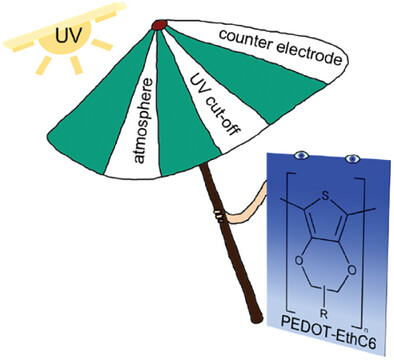
The photostability of roll-to-roll-processed, sidechain-modified poly(3,4-ethylenedioxythiophene) (PEDOT-EthC6) on indium tin oxide coated polyethylene terephthalate (PET-ITO) is improved by excluding ambient atmosphere. In the colored and bleached states, degradation is prevented by 420 and 500 nm long pass filters, respectively. Nickel oxide, as a counter electrode and UV protection, results in ECDs that show no loss of EC performance after 350 h of light exposure.
Electropolymerization of an EDOT-Quinoxaline Monomer for
Green Electrochromic Thin Films and Devices
Polymers / 2024
In this study, we present a 5,8-bis(3,4-ethylenedioxythiophene)quinoxaline monomer with two 4-(octyloxy)phenyl side chains (EDOTPQ) that can be electropolymerized on ITO glass in standard electrolytes containing lithium salts and propylene carbonate as solvent. The electrochemically deposited PEDOTPQ layers show very good adhesion and homogeneity on ITO. The green-colored polymer thin films exhibit promising electrochromic (EC) properties and are interesting for applications such as adaptive camouflage, as well as smart displays, labels, and sensors. Novel organic-inorganic (hybrid) EC cell configurations were realized with Prussian blue (PB) or titanium-vanadium oxide (TiVOx) as ion storage electrodes, showing a highly reversible and fast color change from green to light yellow.
Unraveling the Importance of Water Ratio in
Direct Lithium-Ion Battery Cathode Recycling
Journal of Power Sources Advances / 2023
This study investigates the impact of water ratio on the direct aqueous recycling of NMC811. Three different ratios of NMC811 to water were examined. The results demonstrate that the water ratio significantly affects the electrochemical performance of NMC811. Capacity fading is observed in all water-exposed samples, with the sample having the lowest water ratio showing less fading compared to the samples processed with higher water ratios. Both samples with higher water ratios exhibit similar performance, suggesting an equilibrium at the NMC811-water interface is established. Characterization of the cathode materials reveals variations in the amount and type of surface species. The pristine sample, not exposed to water, only shows Li2CO3 and NiO as surface species, while the water-exposed NMC811 samples exhibit nickel carbonates and hydroxides along with associated water. The poorer performance of samples exposed to higher water ratios is likely due to higher amounts of these species forming on the particle surface. Additionally, lithium, cobalt, and manganese carbonates, as well as lithium hydroxide with associated water, are detected and could further contribute to the poorer performance.
Addition of Multi-walled Carbon Nanotubes to
Fe- and Ru-Metallopolymer Electrodes Enhances
Response Time and Cycling Stability in Electrochromic Cells
ChemElectroChem / 2023
Metallopolymers (MEPEs) show a strong absorption band attributed to a metal-to-ligand charge transfer (MLCT) transition. Fe-MEPE and Ru-MEPE thin films switch reversibly from blue-purple (λmax=584 nm, Fe2+) to colorless (Fe3+) or orange (λmax=518 nm, Ru2+) to pale green (Ru3+). The addition of multi-walled carbon nanotubes (MWCNTs) enhances the electrochromic (EC) properties of Fe- and Ru-MEPE electrodes in several ways: (1) faster response for bleaching/coloring; (2) enhanced Coulombic efficiency; and (3) improved cycling stability, particularly for Ru-MEPE. Moreover, the charge density of the thin film electrodes can be increased upon the addition of the MWCNTs. This performance improvement is demonstrated in electrochromic devices (ECDs) with titanium-doped vanadium oxide (TiVOx) as the optically-passive ion storage layer. The visible light transmittance τv values of the ECDs are improved by the addition of the MWCNTs from 20 %/56 % to 17 %/56 % and from 31 %/47 % and 34 %/55 % in the dark/bright state, for Fe-MEPE and Ru-MEPE, respectively. Thus, the addition of MWCNTs to Fe- or Ru-MEPE is a very promising route for future fast-switching EC applications, e. g., displays, sunroofs, and rear-view mirrors.
Impact of Electrode Architecture on Electrochemical Performance of Aqueous Processed, High-Loaded Lithium-Ion Battery Cathodes
Batteries & Supercaps / 2023
This study compares two electrode architectures, one with a porous carbon current collector (PC) and the other with a state-of-the-art aluminum foil current collector (AF). The results show that the porous carbon outperforms the aluminum foil at high loadings (∼8 mAh/cm2) during cycling, likely due to better adhesion. The characterization methods used in the study include electrochemical cycling, electrochemical impedance spectroscopy (EIS), galvanostatic intermittent titration technique (GITT), and scanning electron microscopy (SEM). These methods provide insight into the performance of the two electrode architectures and allow for a comprehensive comparison between them. The findings of this study indicate that the use of porous carbon as a current collector can lead to improved performance in high-loading electrode applications, making it a promising alternative to traditional aluminum foil current collectors.
Flexible Electrochromic Device on Polycarbonate Substrate with PEDOT:PSS and Color-Neutral TiO2 as Ion Storage Layer
Polymers / 2023
Electrochromic (EC) windows on glass for thermal and glare protection in buildings, often referred to as smart (dimmable) windows, are commercially available, along with rearview mirrors or windows in aircraft cabins. Plastic-based applications, such as ski goggles, visors and car windows, that require lightweight, three-dimensional (3D) geometry and high-throughput manufacturing are still under development. To produce such EC devices (ECDs), a flexible EC film could be integrated into a back injection molding process, where the films are processed into compact 3D geometries in a single automized step at a low processing time. Polycarbonate (PC) as a substrate is a lightweight and robust alternative to glass due to its outstanding optical and mechanical properties. In this study, an EC film on a PC substrate was fabricated and characterized for the first time. To achieve a highly transmissive and colorless bright state, poly(3,4-ethylenedioxythiophene) polystyrene sulfonate (PEDOT:PSS) was used as the working electrode, while titanium dioxide (TiO2) was used as the counter electrode material. They were deposited onto ITO-coated PC films using dip- and slot-die coating, respectively. The electrodes were optically and electrochemically characterized. An ECD with a polyurethane containing gel electrolyte was investigated with regard to optical properties, switching speed and cycling behavior. The ECD exhibits a color-neutral and highly transmissive bright state with a visible light transmittance of 74% and a bluish-colored state of 64%, a fast switching speed (7 s/4 s for bleaching/coloring) and a moderately stable cycling behavior over 500 cycles with a decrease in transmittance change from 10%to 7%.
Development of Silicon Polymer Electrodes with a Hybrid Polymer Electrolyte for All-Solid-State Lithium-Ion Batteries
Journal of The Electrochemical Society / 2023
The development of solid-state lithium-ion batteries is a promising step to meet the increasing demand for safe batteries with a high energy density. In this work, silicon electrodes containing an organic/inorganic hybrid polymer electrolyte (HPE) are reported. Depending on the conducting salt and the inclusion of an ionic liquid (IL), the HPE exhibits an ionic conductivity between 0.24 ± 0.11 mS cm−1 and 0.94 ± 0.07 mS cm−1 at 60 °C. The achievable capacity in Si/HPE/Li cells depends strongly on the C-rate and the areal capacity of the electrodes, as well as on the electrolyte and electrode composition. Among the cells tested, those with an HPE containing lithium bis(fluorosulfonyl)imide (LiFSI) and no IL exhibit the highest capacity retention and average coulombic efficiency. The use of lithium bis(trifluoromethanesulfonyl)imide (LiTFSI) and/or the addition of an IL enables higher electrode loadings, however at the expense of capacity retention. Si electrodes with a higher Si content show an improved cell performance compared to those with less Si. A combination of electrodes containing 75 wt% silicon with an HPE with LiFSI and IL reaches a high capacity of approx. 1500 mA h gSi−1 at 0.1 C with a capacity retention of 74% after 100 cycles.
Photochemical Precharging of Tungsten Trioxide for Enhanced Transmittance Modulation in Flexible Electrochromic Devices
Advanced Materials Technologies / 2023
UV irradiation is used to precharge sputtered tungsten trioxide (WO3) on polyethylene terephthalate enhancing the photochromic response with organic solvents. A comparison between the optical and electrochemical properties of photochemically and electrochemically charged WO3 results in a correlation of the transmittance to the respective charge density. This allows for a precise control of the charge density in the precharging process monitored by UV–Vis spectroscopy. A proof-of-concept flexible electrochromic device combining precharged WO3 (charge density: 20 mC cm−2) and Prussian blue (15 mC cm−2) exhibits a superior change in the visible light transmittance (τv) from 8% (dark) to 79% (bleached) and a coloration efficiency of 139 cm2 C−1 at 716 nm.
Interplay between Elastic and Electrochemical Properties during
Active Material Transitions and Aging of a Lithium-Ion Battery
Batteries & Supercaps / 2023
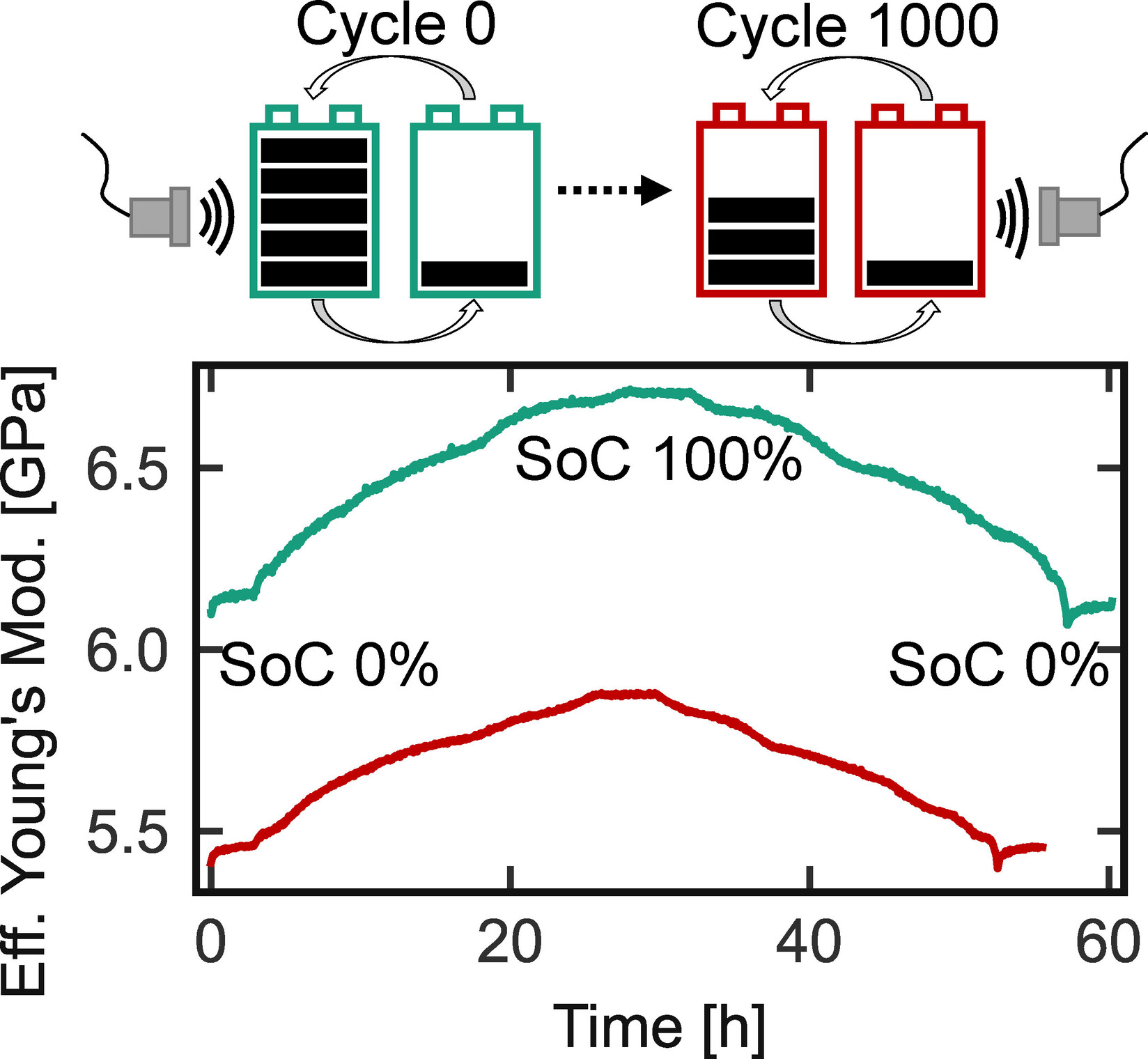
The interplay between the internal mechanical properties and external mechanical conditions of a battery cell, e. g., Young's modulus and thickness change, has a crucial impact on the cell performance and lifetime, and thus, needs to be fully understood. In this work, 12 Ah lithium-ion battery pouch cells were studied during cycling and aging by non-invasive operando ultrasonic and dilation measurements. The effective Young's modulus increases and the thickness varies the most within a single cycle during the graphite transition from stage 1L to 4, at the beginning of the 2 to 1 stage transition and at the phase transition of the nickel-rich NCM from H2 to H3. After 1000 cycles of aging, the overall effective Young's modulus of the lithium-ion battery decreases by ∼11 %–12 % and the cell thickness increases irreversibly by ∼3 %–4 %, which is mostly related to a thicker and possibly softer, more porous solid electrolyte interphase layer.
Consequences of Different Pressures and Electrolytes on the
Irreversible Expansion of Lithium Metal Half Cells
Batteries & Supercaps / 2022
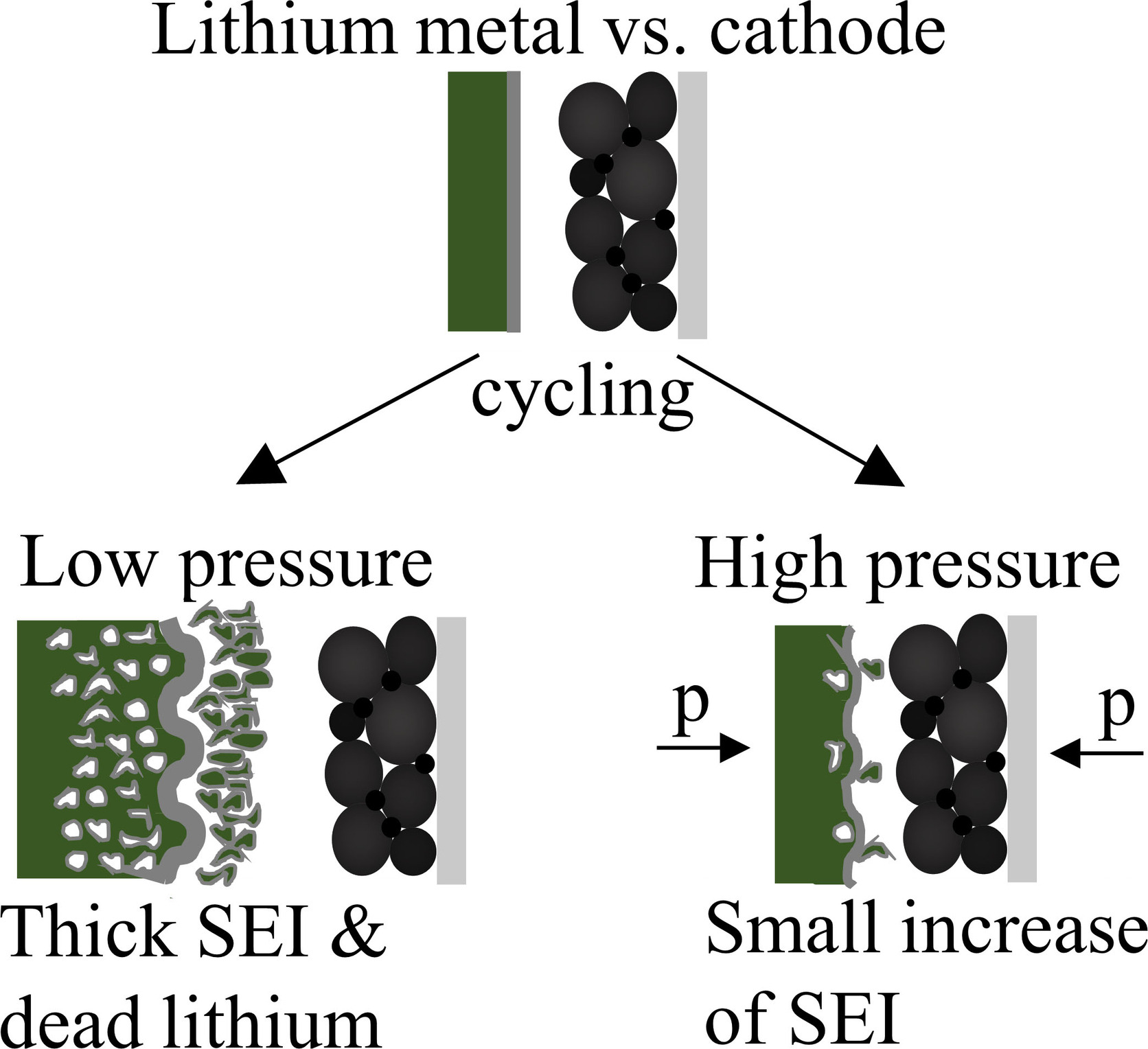
Lithium metal is considered as the ‘holy-grail’ among anode materials for lithium-ion batteries, but it also has some serious drawbacks such as the formation of dendritic and dead lithium. In this study, the interplay of external pressure and different carbonate- and ether-based electrolytes on the (ir)reversible expansion of lithium metal during cycling against lithium titanate and lithium iron phosphate is studied. In carbonate-based electrolytes without any additives, lithium metal shows tremendous irreversible expansion and significant capacity reduction at elevated current densities due to the formation of mossy and dead lithium. The addition of fluoroethylene carbonate can reduce irreversible expansion and capacity reduction, especially when a high external pressure is applied. When an ether-based electrolyte is used, the irreversible dilation of the lithium metal is suppressed when applying increased external pressures. Overall, increased external pressure appears to reduce the formation of mossy and dead lithium and improve the performance.


